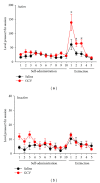Increases in doublecortin immunoreactivity in the dentate gyrus following extinction of heroin-seeking behavior
- PMID: 23213573
- PMCID: PMC3504456
- DOI: 10.1155/2012/283829
Increases in doublecortin immunoreactivity in the dentate gyrus following extinction of heroin-seeking behavior
Abstract
Adult-generated neurons in the dentate gyrus (DG) of the hippocampus play a role in various forms of learning and memory. However, adult born neurons in the DG, while still at an immature stage, exhibit unique electrophysiological properties and are also functionally implicated in learning and memory processes. We investigated the effects of extinction of drug-seeking behavior on the formation of immature neurons in the DG as assessed by quantification of doublecortin (DCX) immunoreactivity. Rats were allowed to self-administer heroin (0.03 mg/kg/infusion) for 12 days and then subjected either to 10 days of extinction training or forced abstinence. We also examined extinction responding patterns following heroin self-administration in glial fibrillary acidic protein thymidine kinase (GFAP-tk) transgenic mice, which have been previously demonstrated to show reduced formation of immature and mature neurons in the DG following treatment with ganciclovir (GCV). We found that extinction training increased DCX immunoreactivity in the dorsal DG as compared with animals undergoing forced abstinence, and that GCV-treated GFAP-tk mice displayed impaired extinction learning as compared to saline-treated mice. Our results suggest that extinction of drug-seeking behavior increases the formation of immature neurons in the DG and that these neurons may play a functional role in extinction learning.
Figures



Similar articles
-
Estrogens dynamically regulate neurogenesis in the dentate gyrus of adult female rats.Hippocampus. 2024 Nov;34(11):583-597. doi: 10.1002/hipo.23633. Epub 2024 Aug 21. Hippocampus. 2024. PMID: 39166359
-
The impact of voluntary wheel-running exercise on hippocampal neurogenesis and behaviours in response to nicotine cessation in rats.Psychopharmacology (Berl). 2024 Dec;241(12):2585-2607. doi: 10.1007/s00213-024-06705-7. Epub 2024 Oct 27. Psychopharmacology (Berl). 2024. PMID: 39463206 Free PMC article.
-
Neurogenesis during Abstinence Is Necessary for Context-Driven Methamphetamine-Related Memory.J Neurosci. 2018 Feb 21;38(8):2029-2042. doi: 10.1523/JNEUROSCI.2011-17.2018. Epub 2018 Jan 23. J Neurosci. 2018. PMID: 29363584 Free PMC article.
-
Insulin growth factor-I promotes functional recovery after a focal lesion in the dentate gyrus.CNS Neurol Disord Drug Targets. 2012 Nov 1;11(7):818-28. doi: 10.2174/1871527311201070818. CNS Neurol Disord Drug Targets. 2012. PMID: 23131164
-
Removal of microglial-specific MyD88 signaling alters dentate gyrus doublecortin and enhances opioid addiction-like behaviors.Brain Behav Immun. 2019 Feb;76:104-115. doi: 10.1016/j.bbi.2018.11.010. Epub 2018 Nov 15. Brain Behav Immun. 2019. PMID: 30447281 Free PMC article.
Cited by
-
Effect of Opioid on Adult Hippocampal Neurogenesis.ScientificWorldJournal. 2016;2016:2601264. doi: 10.1155/2016/2601264. Epub 2016 Apr 5. ScientificWorldJournal. 2016. PMID: 27127799 Free PMC article. Review.
-
Morphine Modulates Adult Neurogenesis and Contextual Memory by Impeding the Maturation of Neural Progenitors.PLoS One. 2016 Apr 14;11(4):e0153628. doi: 10.1371/journal.pone.0153628. eCollection 2016. PLoS One. 2016. PMID: 27078155 Free PMC article.
-
Progenitor Cells Play a Role in Reinstatement of Ethanol Seeking in Adult Male and Female Ethanol Dependent Rats.Int J Mol Sci. 2023 Jul 31;24(15):12233. doi: 10.3390/ijms241512233. Int J Mol Sci. 2023. PMID: 37569609 Free PMC article.
-
Indices of dentate gyrus neurogenesis are unaffected immediately after or following withdrawal from morphine self-administration compared to saline self-administering control male rats.Behav Brain Res. 2020 Mar 2;381:112448. doi: 10.1016/j.bbr.2019.112448. Epub 2019 Dec 20. Behav Brain Res. 2020. PMID: 31870778 Free PMC article.
References
Publication types
MeSH terms
Substances
Grants and funding
LinkOut - more resources
Full Text Sources
Miscellaneous

